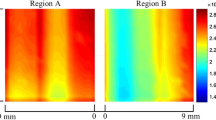Abstract
Small point defect clusters grown-in during Czochralski (Cz) crystal pulling can have an important impact on gate oxide integrity (GOI) for present day high quality silicon substrates. A pronounced effect of the crystal pulling conditions on GOI is indeed observed for gate oxide thicknesses between 10 and 100 nm as was already reported more than 20 years ago [1]. Beginning of the 1980’s the link with microdefects grown-in in the silicon substrate was already made [2,3] but it was only the last five years that this correlation has been studied extensively [e.g. 4–9]. Due to the low density and small size of these grown-in defects, few techniques are available to study their nature which is therefore not yet well understood. Recently, powerful tools based on light scattering using visible [10], near [11] and mid infra red [12] light have become available and allow to reveal the minute lattice defects present in as-grown silicon substrates.
Access this chapter
Tax calculation will be finalised at checkout
Purchases are for personal use only
Preview
Unable to display preview. Download preview PDF.
Similar content being viewed by others
References
Li, S.P. and Maseijian, J. (1976) Effective defect density for MOS breakdown: dependence on oxide thickness, IEEE Trans. Electron Devices ED-23, 525–527.
Itsumi, M. and Kiyosumi, F. (1982) Origin and elimination of defects in Si02 thermally grown on Czochralski silicon substrate, Appl. Phys. Lett. 40,496–498.
Yamabe, K., Taniguchi, K. and Matsushita, Y. (1983) Thickness dependence of dielectric breakdown failure of thermal Si02 films, Proceedings of IRPS, IEEE New York, 184–190.
Itsumi, M., Nakajima, O. and Shiono, N. (1992) Oxide defects originating from Czochralski silicon substrates, J. Appl. Phys. 72, 2185–2191.
Zemke, D., Gerlach, P., Zulehner, W. and Jacobs, K. (1994) Investigations on the correlation between growth rate and gate oxide integrity of Czochralski-grown silicon, Journal of Crystal Growth 139, 37–46.
Satoh, Y., Murakami, Y., Furuya, H. and Shingyouji, T. (1994) Effect of bulk microdefects induced in heat-treated Czochralski silicon on dielectric breakdown of thermal Si02 films, Appl. Phys. Lett. 64, 303–305.
Park, J.-G., Ushio, S., Takeno, H., Cho, K.-C., Kim, J.-K. and Rozgonyi, G.A. (1994) Comparison of oxide breakdown mechanisms due to D-defects and oxygen precipitates, The Electrochemical Society Proceedings Volume 94-33, 53–64.
v. Ammon, W., Ehlert, A., Lambert, U., Gräf, D., Brohl, M. and Wagner, P. (1994) Gate oxide related bulk properties of oxygen doped floating zone and Czochralski silicon, The Electrochemical Society Proceedings Volume 94-10, 136–147.
Fusegawa, I., Takano, K., Kimura, M. and Fujimaki, N. (1995) Review of the influence of micro crystal defects in silicon single crystals on gate oxide integrity, Material Science Forum Vols. 196–201, 1683–1690.
Wagner, P. (1995) Automated surface inspection of bare polished silicon surfaces with light scattering techniques, Electrochemical Society Proceedings Volume 95-30, 236–251.
Moriya, K. (1989) Observation of micro-defects in as-grown and heat treated Si crystals by infrared laser scattering tomography, Journal of Crystal Growth 94,182–196
Voronkov, V.V., Zabolotskiy, S.E., Kalinushkin, V.P., Murin, D.I., Ploppa, M.G. and Yuryev, V.A. (1990) Application of elastic IR light scattering for investigation of large-scale electrically active defects in semiconductors, Journal of Crystal Growth 103,126–130.
Kissinger, G., Vanhellemont, J., Graf,, D., Claeys, C. and H. Richter (1996) IR-LST a powerful tool to observe crystal defects in as-grown silicon, after device processing, and in heteroepitaxial layers, Inst.. Phys. Conf. Ser., in press.
Yamagashi, H., Fusegawa, I., Fujimaki, N. and Katayama, M. (1992) Recognition of D defects in silicon single crystals by preferential etching and effect on gate oxide integrity, Semicond. Sci. Technol. 7, A135–A140.
Vanhellemont, J., Kissinger, G., Gräf, D., Kenis, K., Depas, M., Mertens, P., Lambert, U., Heyns, M., Claeys, C., Richter, H. and Wagner, P. (1995) Lattice defects in high quality as-grown Cz silicon, studied with light scattering and preferential etching techniques, Materials Science Forum Vols. 196–201, 1755–1760.
Vanhellemont, J., Kissinger, G., Gräf, D., Kenis, K., Depas, M., Mertens, P., Lambert, U., Heyns, M., Claeys, C., Richter, H. and Wagner, P. (1996) Light scattering tomography study of lattice defects in high quality as-grown Cz silicon wafers and their evolution during gate oxidation, Inst. Phys. Conf. Ser., in press.
Dornberger, E. and von Ammon, W. (1996) Dependence of ring like distributed stacking faults on the axial temperature gradient of growing Czochralski silicon crystals, J. Electrochem. Soc., in press.
Ryuta, J., Morita, E., Tanaka, T. and Shimanuki, Y. (1992) Effect of crystal pulling rate on formation of crystal-originated particles on Si wafers, Jap. J. Appl. Phys. 31, L293–L295.
Brohl, M., Gräf, D., Wagner, P., Lambert, U., Gerber, H.A. and Piontek,H. (1994) Monitoring of crystal bulk defects on polished Si (l00)-surfaces, The Electrochem. Soc. Extended Abstracts 94-2, 619–620.
Lee, J.C., Chen, I.C. and Hu, C. (1988) Modelling and characterisation of gate oxide reliability, IEEE Trans. Electron Devices 35, 2268–2278.
Iwasaki, T., Harada, H. and Haga, H. (1995) Influence of point defect concentration in growing Cz-Si on the formation temperature of the defects affecting gate oxide integrity, Materials Science Forum Vols. 196–201, 1731–1736.
Vanhellemont, J. (1996) On the impact of interface energy and vacancy concentration on morphology changes and nucleation of silicon oxide precipitates in silicon, Appl. Phys. Lett., in press.
Author information
Authors and Affiliations
Editor information
Editors and Affiliations
Rights and permissions
Copyright information
© 1996 Kluwer Academic Publishers
About this chapter
Cite this chapter
Vanhellemont, J. et al. (1996). On the Impact of Grown-in Silicon Oxide Precipitate Nuclei on Silicon Gate Oxide Integrity. In: Jones, R. (eds) Early Stages of Oxygen Precipitation in Silicon. NATO ASI Series, vol 17. Springer, Dordrecht. https://doi.org/10.1007/978-94-009-0355-5_40
Download citation
DOI: https://doi.org/10.1007/978-94-009-0355-5_40
Publisher Name: Springer, Dordrecht
Print ISBN: 978-94-010-6645-7
Online ISBN: 978-94-009-0355-5
eBook Packages: Springer Book Archive




